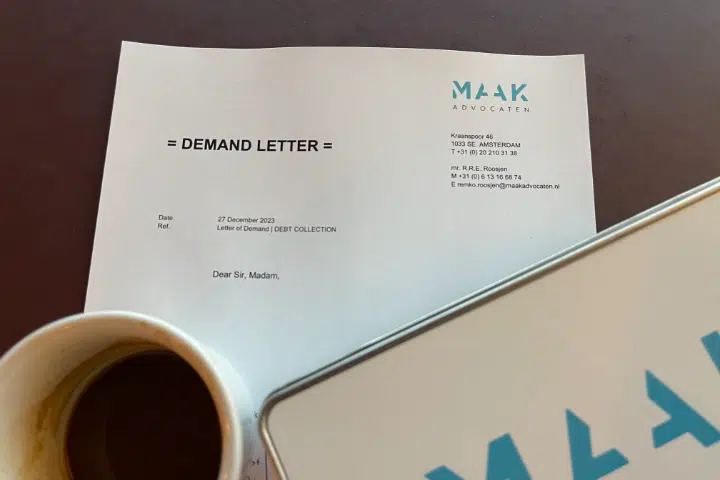
As a Dutch debt collection lawyer, I know that when it comes to drafting a demand letter under Dutch law, it is essential to approach the task in a professional and methodical manner. The intricacies of Dutch law require careful attention to detail and adherence to specific guidelines. By understanding the purpose of the demand letter, effectively addressing the recipient, and clearly outlining the breach of contract or failure to fulfill obligations, individuals can set the stage for a successful legal claim. Join us as we delve into the crucial elements of writing a demand letter under Dutch law, providing invaluable insights and practical advice to navigate this complex process.
Example of a Demand Letter under Dutch law
Purpose of the Demand Letter under Dutch law
The purpose of the demand letter is to communicate the reasons for the demand, including any breach of contract or non-performance, professionally and concisely. Under Dutch law, a demand letter is an effective tool to initiate the resolution of disputes and to seek payment or other forms of relief. It serves as a formal notice to the other party, notifying them of their obligations and the consequences of their non-compliance.
In the demand letter, it is essential to outline the specific terms and conditions of the contract that have been violated or not fulfilled. This includes identifying the relevant clauses and providing evidence of the breach, such as correspondence, invoices, or other supporting documents. The letter should also clearly state the desired outcome, whether it is the payment of a certain amount, termination of the agreement, or any other form of resolution.
Moreover, the demand letter can serve as a precursor to legal action. By clearly articulating the reasons for the demand and the potential consequences of non-compliance, it can demonstrate to the other party that the matter is being taken seriously and that legal action may be pursued if necessary. Therefore, it is crucial to ensure that the demand letter is written professionally, adhering to the formalities and requirements of Dutch law.
Seeking legal advice before drafting the letter can help increase the chances of a successful outcome and provide guidance on the specific legal requirements.
What constitutes expiration and interruption of claims under Dutch law?
Under Dutch law, a claim is subject to expiration after a specific limitation period, often five (5) years from the claim’s inception. However, this expiration can be interrupted, thus extending the claim’s validity. Initiating a debt collection procedure by a Dutch debt collection attorney or sending a demand letter can serve this purpose. The act of interruption aims to alert the debtor to the creditor’s intent to pursue the claim.
Legal Requirements for a Demand Letter in the Netherlands
To ensure a demand letter effectively interrupts a limitation period under Dutch law, it is crucial to adhere to specific requirements. Dutch legal regulations demand absolute clarity in the content of such letters. Ambiguity or vague language is not tolerated. In practical terms, this means that the demand letter must explicitly state the creditor’s claim, leaving no room for interpretation or misunderstanding.
In addition to a clear statement of the claim, the demand letter should also specify the exact amount owed. It should leave no doubt as to the creditor’s entitlement to this specified amount. This clarity not only aligns with legal standards but also serves as a strong and persuasive communication tool. Furthermore, the demand letter should include a clear reservation of rights by the creditor to claim the specified amount. This reservation reinforces the creditor’s position and intentions, indicating that they are prepared to take legal action if necessary to recover the debt.
In summary, under Dutch law, a demand letter’s effectiveness in interrupting a limitation period hinges on its absolute clarity, leaving no room for uncertainty regarding the creditor’s claim, the specific amount owed, and the creditor’s determination to pursue their rights through legal means if necessary.
The Burden of Proof and Delivery of Demand Letters under Dutch law
A crucial and often underestimated aspect of utilizing a demand letter in Dutch legal proceedings is the onus of proving its delivery to the intended recipient. In legal matters, ensuring that your communication is not only sent but also received and acknowledged is of paramount importance.
Under Dutch law, the burden of proof regarding the letter’s delivery rests squarely on the sender’s shoulders. This means that it’s not sufficient to simply send the letter; you must also demonstrate if required, that it reached its intended destination. Failing to do so can jeopardize the effectiveness of the demand letter and the subsequent legal proceedings. To safeguard against any potential disputes regarding delivery, it is not only common practice but highly recommended to dispatch crucial letters, such as demand letters, via registered mail. Registered mail provides tangible proof of delivery in the form of a receipt with the recipient’s signature or acknowledgment, which is admissible as strong evidence in court.
Alternatively, in the modern digital age, courts in the Netherlands generally accept fax receipts or email proofs as valid evidence of delivery, provided that they offer a clear record of transmission and receipt. However, relying solely on electronic means of communication may introduce a level of uncertainty, as it can be more challenging to prove receipt compared to registered mail.
In conclusion, when sending a demand letter in Dutch legal proceedings, it is essential to not only draft a compelling and legally sound document but also to take proactive measures to prove its delivery, whether through registered mail or electronic means, to ensure its effectiveness in pursuing your legal claims.
Addressing the Debtor with a Dutch demand letter
When addressing the recipient of a demand letter under Dutch law, it is crucial to verify the correct address, especially for companies. Ensuring that the letter reaches the intended recipient is essential for the effectiveness of the demand. In the case of companies, it is important to address the letter to the appropriate person or department responsible for handling such matters. This helps to avoid any delays or confusion caused by the letter being forwarded to the wrong individual.
To address the recipient effectively, it is advisable to tailor the demand letter to their role and responsibilities. This ensures that the recipient understands their obligations and the potential consequences of non-compliance. It is also important to ensure that the letter reaches the decision-maker rather than getting lost in bureaucratic processes. Therefore, it may be necessary to do some research or make inquiries to identify the right person to address the demand letter to. In addition to traditional mail, demand letters can also be served via email if this method of communication has been previously used between the parties. However, it is important to ensure that the recipient’s email address is accurate and up-to-date.
Understanding the Breach
To effectively address a breach situation under Dutch law, it is essential to have a clear understanding of the specific breach and its implications. Breach occurs when one party fails to fulfill their obligations under a contract, which can include non-payment, non-performance, or violation of terms and conditions. Understanding the nature and consequences of the breach is crucial for determining the appropriate legal action to take. In the context of writing a demand letter under Dutch law, the understanding of the breach plays a pivotal role. The demand letter serves as a formal communication to the breaching party, outlining the specific breach and requesting appropriate remedies, such as compensation for damages or termination of the agreement. It is important to clearly state the reasons for the demand, providing evidence of the breach and its impact. Dutch law provides certain rights and remedies for breach situations. The specific legal provisions may vary depending on the nature of the breach and the terms of the contract. Seeking legal advice is advisable to ensure compliance with Dutch law and to increase the chances of a successful outcome.
Consequences of Non-Compliance under Dutch law
Non-compliance with the obligations outlined in Dutch law can result in a range of adverse consequences. When it comes to writing a demand letter under Dutch law, it is important to understand the potential ramifications of non-compliance. Failure to comply with the requirements and obligations outlined in Dutch law can lead to legal action and other negative consequences. Here are some potential consequences of non-compliance:
| Consequences of Non-Compliance |
|---|
| Accrual of statutory interest and potential legal action for non-payment |
| Weakened legal position in Dutch debt collection proceedings due to non-compliance with proper debt collection procedures |
| Misunderstandings and jeopardized effectiveness of the demand letter due to inaccurate or improper communication |
| Legal disputes, potential damages, and loss of legal rights by ignoring termination processes and requirements when ending a contract |
| Disputes, financial repercussions, and legal consequences resulting from a lack of understanding and adherence to termination notice processes and legal obligations |
To avoid these adverse consequences, it is crucial to ensure compliance with Dutch law when writing a demand letter. Seeking legal advice can help ensure that the letter is in line with Dutch legal requirements and increase the chances of a successful outcome. By understanding the potential consequences of non-compliance, parties can take appropriate actions to resolve disputes and protect their legal rights.
Creditor’s Rights and Desired Outcome
The creditor’s entitlements and intended result are crucial aspects to consider when addressing their rights and desired outcome in a demand letter under Dutch law. It is important to understand the creditor’s rights within the legal framework and tailor the desired outcome accordingly. Here are five key considerations to keep in mind:
- Legal rights: The demand letter should outline the creditor’s legal rights in the specific context of the case, highlighting any relevant Dutch laws or regulations that support their position.
- Contractual obligations: If the dispute arises from a contractual relationship, the letter should clearly articulate the creditor’s rights and obligations as stipulated in the contract.
- Desired outcome: The creditor should specify their desired outcome in the demand letter, whether it is seeking financial compensation, termination of the agreement, or another resolution that aligns with their goals.
- Reasonable expectations: It is important to assess the creditor’s desired outcome in light of the circumstances and the applicable legal principles to ensure it is reasonable and achievable.
- Legal advice: Seeking legal advice is crucial to understanding the creditor’s rights and determining the appropriate desired outcome. An experienced lawyer can guide the best approach to achieve a favorable result.
Language and Tone of the Demand Letter
When drafting a demand letter under Dutch law, it is important to maintain a professional and respectful tone while clearly expressing the creditor’s requirements. The language and tone of the letter play a crucial role in effectively conveying the creditor’s demands and increasing the chances of a favorable outcome. The demand letter should be written in Dutch, as it is the official language of the Netherlands.
To ensure clarity and precision in the communication, it is advisable to avoid using aggressive language or making threats in the demand letter. Instead, the letter should adopt a formal and professional tone, maintaining courtesy and respect throughout. This will help to establish a cooperative and constructive atmosphere, facilitating a more amicable resolution.
To maintain conciseness and clarity, the demand letter should be written directly and assertively. It should clearly state the demand for payment or action, leaving no room for ambiguity or confusion. Using a table can be a useful tool to organize and present the creditor’s requirements in a structured and easy-to-follow format.
Signing and Dating the Demand Letter
To ensure the formal and legal validity of the demand letter, it is essential to properly sign and date the document. This step is crucial as it serves as proof of when the letter was sent and received, and it adds credibility to the claims made in the letter.
When signing and dating the demand letter under Dutch law, it is important to follow these guidelines:
- Print your full name and position in the company.
- Sign the letter by hand using blue or black ink.
- Include the date of signing, which should be the same as the date on the letter.
- If the letter is being sent on behalf of a company, include the company’s name and address.
- Ensure that the signing and dating are done before the letter is sent to the recipient.
Conclusion
In conclusion, writing a demand letter under Dutch law requires careful consideration of several key factors:
- Purpose: Clearly define the purpose of the letter and what specific demand or action you are seeking.
- Recipient: Identify the individual or entity to whom the letter is addressed. Make sure to include accurate contact information.
- Breach: Clearly explain the specific breach of contract or legal violation that has occurred. Provide relevant details and any supporting evidence.
- Consequences: Explain the negative impact that the breach or violation has had on the creditor or their rights. Outline any damages or losses suffered.
- creditor’s rights: Highlight the rights and legal protections that the creditor is entitled to under Dutch law. This will strengthen your argument.
- Desired outcome: Clearly state what you expect the recipient to do in response to the demand. Be specific and realistic in your expectations.
- Language and tone: Use clear and concise language, avoiding unnecessary jargon or complex legal terms. Maintain a professional and respectful tone throughout the letter.
- Proper signing and dating: Sign the letter with your full name and title, if applicable. Include the date to establish the timeline of your demand.
By adhering to these guidelines, individuals can effectively communicate their demands and navigate the legal process in pursuit of a favorable outcome.
Seeking legal counsel is recommended to ensure compliance with Dutch law and enhance the likelihood of success.


